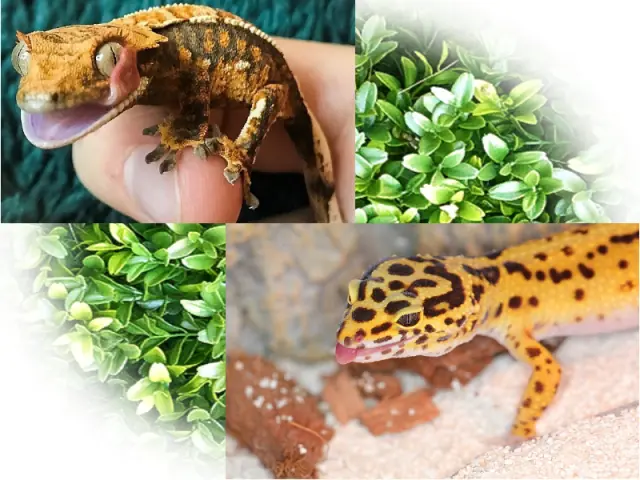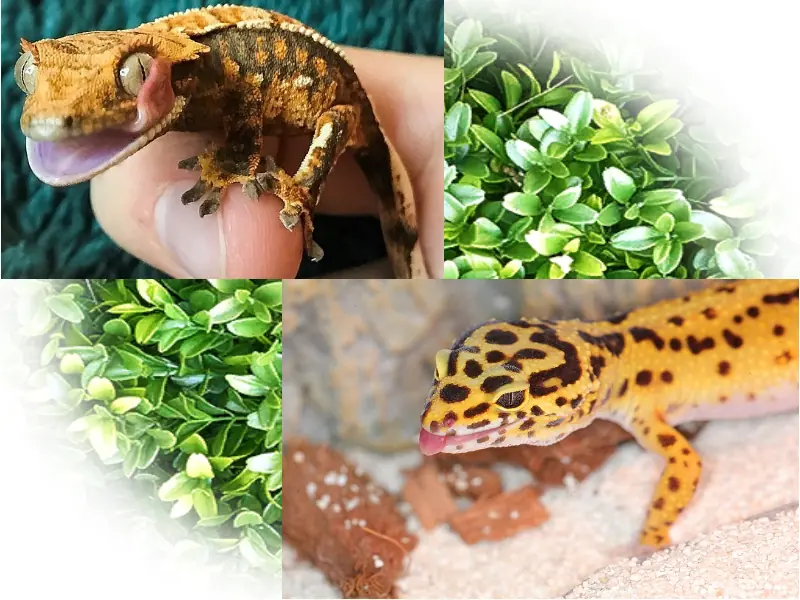Having a Gecko as a pet is becoming more and more popular as these small lizards can make excellent companions. They’re typically quiet and they don’t require lots of attention. On the other hand, they look very interesting and they’re great to observe what they’re doing when they finally get out of their hideouts.
Two of the most popular choices around the world are the Crested Gecko and the Leopard Gecko. They’re quite different creatures but they make excellent pets if you love geckos. In this article, we’ll talk about these two geckos and help you figure out which one is a better choice for you.
Crested Gecko: If you’re looking for a unique-looking gecko, you don’t need to search further. The Crested Geckos are also known as “Eyelash” Geckos because of the small crests right above their eyes that mimic eyelashes perfectly. They were rediscovered in 1994 as they were thought to be extinct for sure. They can be a bit feisty but they get used to handling eventually.
Leopard Gecko: If you’re in search of the easiest gecko to take care of as a beginner, the Leopard Gecko is the choice for you. These geckos are actually very well-known and they’re highly recommended for first-time owners. This is because of how docile and easy to tame they can be. They’re perfect for children that just discovered their love for reptiles and are begging you for a gecko.
Crested Gecko vs Leopard Gecko – Which One Is The Better Pet?

These geckos might not be too big but don’t underestimate them at all. They are incredible athletes and they can make some very impressive jumps. In fact, the most interesting thing about them is that they use their own tails as support to make bigger jumps. This means that you need to be very careful when you’re handling them as they might try to jump down and they can break something very easily.
Leopard Geckos grow up to 8 inches as well and they can live around 15 years in captivity. They can live even longer if they’re properly taken care of. These beautiful creatures are very docile and a joy to tame and teach easy tricks to. They’re not very stubborn and they actually enjoy it when you’re handling them properly. It might take some time, but you will find a very close friend in your Leo (a popular nickname for Leopard Geckos).
Temperament and Habits Comparison
While they love to bite as juveniles, they stop doing that as adults and they become easier to tame. This means they will start allowing you to take them in your hands for short periods of time. They will only allow you to hold them up to 5 minutes until they get used to you. And while captivity-bred Crested Geckos are easier to tame, wild-caught ones should be avoided as they’re very aggressive and could have all sorts of diseases.
Crested Geckos can be quite funny to observe as they’re active and they do all sorts of movements that make you watch them for hours. Their enclosures are also often referred to as “Cat TV” as a cat would stay all day in front of the tank and follow the gecko very closely. This is why you should make sure the enclosure is 100% secure and nothing can get in and hurt the gecko.
You should almost never expect a bite from a Leopard Gecko. It will gladly run into hiding instead of picking a fight. But you should still be careful when you’re handling it as your Leo can get scared of you if you are too rough during playtime. If you manage to befriend one, it will love spending time with you as long as you’re not hurting them
These geckos are a much better choice for children as they’re sweet and won’t hurt the child even if they bite. A crested gecko’s bite is completely harmless to adults but it might sting a bit for children. On the other hand, a Leo will never attack unless it thinks it’s in danger.
Can Crested Geckos and Leopard Geckos live together?
Housing a Crested Gecko and a Leopard Gecko together is a recipe for disaster. They will start fighting over the territory and they won’t stop fighting until one of them drops their tail and runs into hiding or is dead. Crested Geckos might be feisty, but they’re not very strong. A Leopard Gecko will most likely kill a Crested Gecko if given the chance, despite them being around the same size.
You should never house geckos from different species together, and you should also avoid placing two males in the same vivarium. Don’t attempt to do it even if it’s temporary. The males are very territorial, and if there’s a female around, the fight will be even worse.
Diet Comparison
A Crested Gecko needs to eat both insects and fruits, but the insects should always be the base of each meal. After the gecko has eaten a few insects, you can start feeding it thin slices of fruit or mixed in a puree with baby food. These geckos absolutely love baby food and you can give it to them up to 3 times a week.
Mango, banana, peach, and other tropical fruits are excellent for a crested gecko. But you need to make sure nor the insects nor the fruit pieces are bigger than the space between the gecko’s eyes. This will ensure that it won’t choke while it eats. The fruits should be blended in a puree or sliced into extremely thin slices.
Leopard Geckos can eat a very wide range of insects as well. This includes crickets, mealworms, waxworms, butterworms, etc. You just have to make sure the size of each insect is not bigger than the space between its eyes. And since these geckos store any extra fat in their tails, they can eat insects that are much higher in fat than other geckos.
Comparison – Cage Requirements (size, substrate, heat level, humidity)
Crested Geckos don’t grow too big, which means a 15-gallon tank is excellent for them from the moment you got them. Many reptile owners would change the cage once the gecko has reached maturity, but since they remain small in size, you can keep using the same cage forever. As a substrate, it’s recommended to use either coconut husk or soil.
Their preference when it comes to heat is between 78F and 82F. And at night, it’s OK if it drops below 70F. It’s always best to have one side heated up and one cool. While it simply walks around the enclosure, it can regulate its body temperature. And when it comes to humidity, they need it to remain constantly between 60% and 70%.
Leopard Geckos can live OK in a 10-gallon tank but you should opt for an enclosure that is at least 15 gallons. And if you plan on keeping a pair, you might want to look for a 25-gallon tank. They need a lot of space to live a happy life.
When it comes to substrates, reptile carpets are the most recommended. But you can also use coconut husks or excavator clay. The ideal temperature is between 75F to 80F on the cool side, 80F to 85F on the warm side, and you’ll also have to provide a 90F to 95F basking area. On the other hand, the humidity level this gecko needs is very low. Between 30% to 40% should be more than enough as they need a relatively dry environment.





